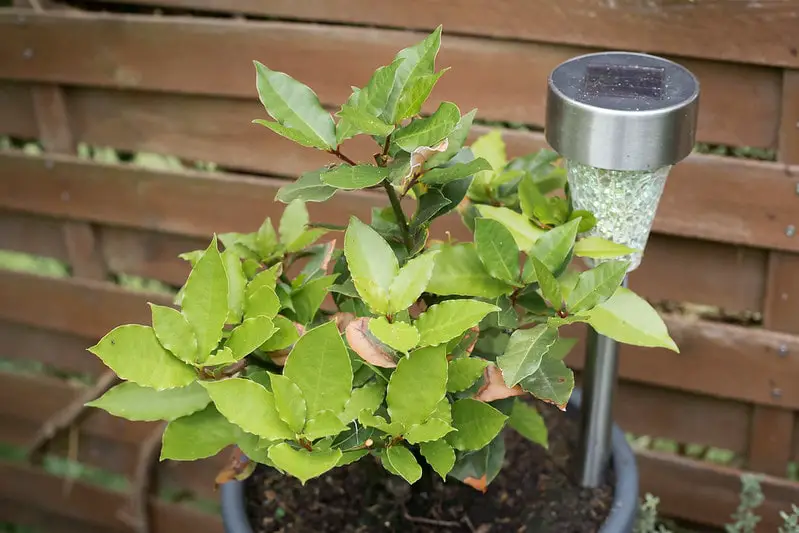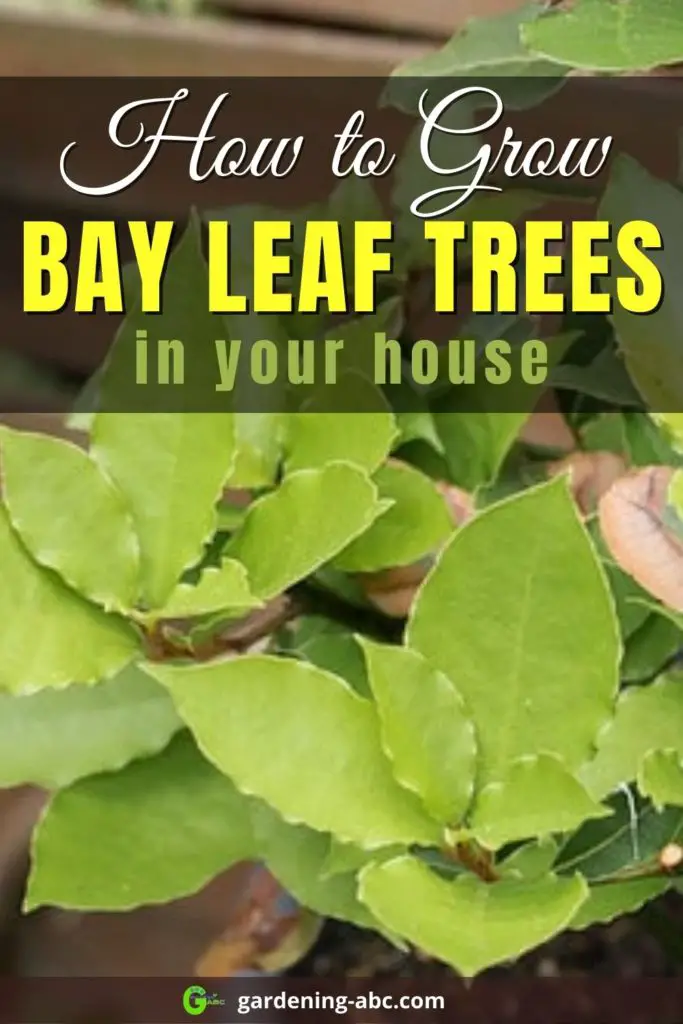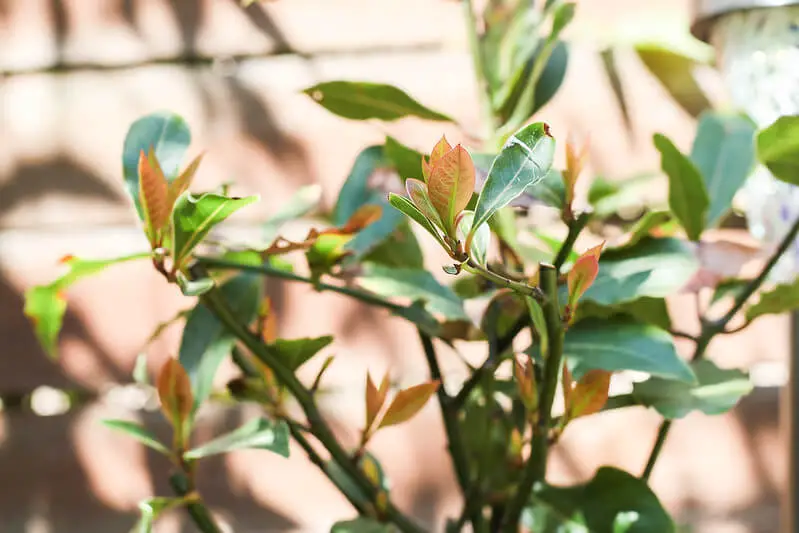We use affiliate links to run our site. When you buy through links on our site, we may earn an affiliate commission, without any added cost to you. Learn more
Are you looking for a way to add some flavor to your recipes? Why not grow your own bay leaves at home? Not only will you have a never-ending supply of fresh leaves to use, but you’ll also get to enjoy the satisfaction of growing your own herbs.
Bay leaves (Laurus nobilis) are a wonderful addition to soups, stews, and braises, and their aromatic flavor is essential to many classic dishes.
Bay leaves are a type of evergreen tree that is native to the Mediterranean. They can grow up to 60 feet tall, but most home growers keep them potted and much smaller.
Growing your own bay leaves at home is easy, and with a few simple tips, you can have a thriving plant that will provide you with an abundance of flavorful leaves.
Here are some tips for growing a healthy and productive Bay Leaves plant:
Table of Contents
how to grow bay leaf Plants/Bay Laurels
Keypoints [In A Nutshell]:
| Botanical Name | Bay Laurel (Laurus nobilis) |
|---|---|
| Common Names | Bay tree, Sweet bay, True laurel |
| Family | Lauraceae |
| Plant Type | Evergreen shrub/tree |
| Mature Size | 15-40 feet in height, 5-10 feet spread |
| Sun Exposure | Full sun to partial shade |
| Soil Type | Well-draining, loamy soil |
| Soil pH | Slightly acidic to slightly alkaline (pH 6.0 – 7.5) |
| Bloom Time | Spring |
| Flower Color | Yellow-green |
| Hardiness Zones | 8-11 (USDA) |
| Native Area | Mediterranean region |
| Watering | Moderate, allowing the top inch of soil to dry between waterings |
| Fertilizing | Fertilize once a month with balanced liquid fertilizer during the growing season |
| Light Requirements | Bright, indirect light |
| Temperature and Humidity | Average to warm temperatures, and moderate to high humidity |
| Harvesting | Leaves can be harvested once the plant is established and large enough |
| Propagation | Propagate through semi-hardwood cuttings in late summer or by seeds |
| Common Varieties | ‘Saratoga’, ‘Aurea’, ‘Angustifolia’ |
| Common Issues | Overwatering leading to root rot, pests like scale insects and mealybugs, and powdery mildew in humid conditions |
What is A bay leaf Tree:
The Bay leaves tree is a perennial evergreen and is native to the Mediterranean. They are a slow-growing plant but if the conditions are right a mature bay leaf plant can grow up to 10 to 30 feet tall and 5 to 20 feet wide in its native environment.
Bay leaves are easy to identify. They are famous for their shiny, dark green oval-shaped leaves. If you touch the leaves you will feel the leathery texture. The leaves are very popular in kitchen seasoning.
where to plant bay laurels:
To get the most out of your bay leaf tree, it is important to plant it in the right spot. Bay leaf trees need full sun to thrive.
Choose a spot in your yard that gets at least six hours of direct sunlight each day. Bay leaves can be a good addition to your kitchen garden since you will need them frequently in your recipes.
How To select the Soil:
When it comes to bay leaf trees, the soil is just as important as the tree itself. After all, the tree will only be as healthy as the soil it’s grown in.
The ideal soil for growing Bay leaves is slightly acidic soil with a pH of 6.0 to 7.0. If the soil is too alkaline, the leaves of the tree will be yellow and drop off.
Always use a soil pH tester like this to find out the exact pH of the soil. If your soil is particularly alkaline in nature, use these steps to make it suitable for the plant’s needs.
Water:
Bay trees have a very shallow root system, so watering should be frequent, especially during summer. Between two watering give time for the soil to dry up.
Temperature:
Bay trees cannot tolerate cold weather. It is only hardy in USDA hardiness zones 8 through 10. They also cannot tolerate extreme heat. So if you live in a warm climate, arrange some shade for your bay tree.
If you are growing bay leaves in containers you can control the temperature easily. But remember if you bring the plant indoors for the winter keep the humidity level high by using a humidifier like this or simply use a mister to mist the plant with water.

How to Propagate Bay Leaves:
You can propagate bay trees in 2 ways:
1. From bay leaf seeds:
To propagate bay leaves trees from seeds, first, separate the seeds from the flesh of the berry, and plant it. If the seeds are not fresh, soak them in warm water for a day before planting.
Keep the soil moist and maintain a temperature around 70 F. You can use a soil thermometer to get an accurate measurement. If the temperature is around the ideal mark, it usually takes 10-20 days for the bay leaf seeds to germinate.
2. From Cuttings:
The best time to propagate bay trees from cuttings is in late summer and early autumn.
Select young side shoots that are about 10-15cm long. Then cut them off from the main plant.
Remove the lower leaves and any trailing strands of bark from the shoot.
Now plant those bay tree cuttings in a good quality growing medium and keep the cutting in a place where it does not get any direct sunlight.
When to Plant Bay:
The best time to plant bay saplings is in the fall or early spring. This will give them the chance to get settled before the heat of the summer.
How to Plant Bay Trees:
Before planting the tree add compost to the soil. This will not only increase the fertility of the soil but also improve drainage.
Dig a hole as deep as the root ball. Give enough space for the roots to spread out.
Plant the bay tree, and gently fill in and tamp the soil around it. Add water thoroughly.
Fertilizer:
Fertilize your bay tree with a good organic fertilizer. Apply the fertilizer twice a year, once in the spring and once in the summer.
Growing Bay in Containers:
You can also grow bay leaves in containers. In containers, the quality of the soil is very important to grow any plant. So when you grow bay leaves in containers, use a good-quality potting mix.
Water the plant regularly so it does not die out of thirst. Apply an organic liquid fertilizer from time to time to feed the bay tree.
Every couple of years repot your bay leaf tree. While repotting mix a handful of good-quality compost with the soil.
During the cold winter cover the pot with insulative materials.
Flowers and Leaves:

The bay plant is unisexual, which means they produce male and female flowers on separate plants. The pale yellow-green flowers are borne in pairs beside the leaves. They start appearing in springs, mature over the summers, and form blackish-purple fruits in the fall.
Each fruit contains a single bay leaf seed.
The bay leaves are glabrous, 6–12 cm long, and 2–4 cm broad, with an entire (untoothed) margin.
Bay Leaf Varieties:
Though there are many varieties of bay trees available not all are suitable for edible purposes. if you plan to use the leaves for cooking and eating only plants Laurus nobilis.
Some of the most common varieties of bay leaf trees are:
Laurus nobilis ‘Angustifolia’:
They are narrow, pale green leaves with wavy edges. These leaves are also a bit hardier than a common bay.
Laurus nobilis (Common bay):
Common bays have dark green, aromatic leaves.
Laurus nobilis ‘Aurea’:
These are showy golden leaves and slightly hardier than a common bay.
Bay Leaf Tree As A Hedge:
Though Bay trees are used as culinary herbs for their aromatic leaves, they are also fine evergreen hedges or topiary plants. A little bit of pruning in the summer will help you keep the hedge in good shape.
As there are various varieties of bay leaf plants, the actual number for creating a hedge will depend on the variety.
Bay tree hedges can survive the winter only if they do not get any frost.
Pruning Bay Leaves:
Pruning is very important for bay leaf trees. If you do not prune the tree, it can become a giant (60 ft tall). Pruning keeps the plant to a manageable size, with selective pruning it can grow into a beautiful ornamental plant. Use proper pruning tools so the plant doesn’t get damaged,
how to harvest Bay Leaves:
Usually, after a couple of years, your bay leaf plant is ready for harvesting. You can harvest bay leaves at any time. It is best to use bay leaves fresh, so pick the leaves whenever you need them.
While harvesting, pick the largest leaves first, they have a more intense flavor than the younger ones. Use your hands to snip off large, unblemished leaves. Next, lay the leaves out on a dry cloth, without overlapping.
You can also dry the leaves and store them for future uses. For this, harvest the leaves in the midsummer when the essential oils, are at their peak, so the leaves will retain their flavor for a longer period of time. Keep the leaves for a year (after that they tend to lose their flavors) in airtight containers.
Common Pests and Diseases of A bay leaves plant:
Followings are some of the common problems of growing bay trees.
Yellow Leaves:
The bay leaves turning yellow is usually a sign of waterlogging or the effect of cold weather. Sometimes lack of nutrients can also cause the leaves to turn yellow, especially in container-grown bay trees.
Trim off damaged branches and leaves. Make sure the drainage is good for the soil. Improve the nutrients of the soil by adding a general-purpose organic fertilizer every two weeks until August.
Bay Leaf Spots:
The main issue with this is soil waterlogging or wet weather. If you are growing the bay in a container, try to repot it. This usually solves the problem.
Ensure containers have a thick layer of drainage material at the bottom of the pot, and enough drainage holes for excess water to easily flow through.
Peeling of Bark:
This is quite common in harsh winters. If the plant is growing normally you don’t need to worry too much about this problem. Once the weather improves the problem will go off.
Brown Leaves:
The browning of bay leaves is mainly due to environmental problems. Improve the drainage of the soil, and recheck your watering schedules.
Plant Leaves Curling With Pale-yellow/ Brown Edges:
The main reason the leaves start curling and look discolored is they may have been affected by grey-white insects. Check under the leaves for those insects. Pick them off and dispose of the affected leaves.
Horse Chestnut Scale:
Bay trees often get infested with horse chestnut scale. You will find these insects on the underside of leaves or on stems.
To remove these insects use predatory insects. They will reduce the insect population. Even if you don’t do anything, the growth of the bay will hardly get affected.
Edible Uses for Bay Leaves:
You can use bay leaves fresh or dried. Dried leaves generally have a stronger flavor than fresh ones.
Bay leaves are an integral part of French cuisine. The leaves are used in combination with other herbs and spices throughout the world.
Conclusion:
Bay trees are not only beautiful they are very functional. They are easy to take care of and have very few pests and disease problems. You not only get leaves that have culinary and medicinal uses but also a houseplant that will add to your aesthetics.
The right amount of light, temperature, and moist soil moist and you are ready to grow bay leaves.
Like the post? Don’t Forget to PIN IT.

Frequently Asked Questions (FAQs):
How long does it take to grow a bay leaf tree?
The time it takes to grow a bay leaf tree from seeds to a mature plant can vary depending on the growing conditions and care provided. On average, it may take approximately 2 to 3 years for a bay leaf tree to reach a size where leaves can be harvested for culinary use.
Is bay leaf an indoor plant?
Yes, bay leaf trees can be grown indoors, but they require adequate sunlight. Place the potted bay leaf plant near a south-facing window or provide sufficient artificial light to ensure it receives around 6 to 8 hours of sunlight daily.
Do bay leaves need sun?
Yes, bay leaf trees need sunlight to thrive. They prefer a sunny location with at least 6 to 8 hours of direct sunlight per day. Adequate sunlight helps promote healthy growth and enhances the flavor of the bay leaves.
What season does the bay leaf tree grow?
Bay leaf trees are evergreen and can grow throughout the year. However, they experience more active growth during the warmer months of spring and summer.
What is the best climate for bay leaf?
Bay leaf trees thrive in Mediterranean climates, where they can receive ample sunlight and well-draining soil. They are also well-suited to regions with mild winters and warm summers.
Why are my bay trees dying?
Several factors can contribute to the decline of bay trees, including overwatering, poor drainage, inadequate sunlight, pest infestations, or diseases. Proper care, including proper watering and pest control, is essential to maintain the health of the trees.
What is the best fertilizer for bay trees?
Bay trees generally do not require heavy fertilization. A balanced, slow-release fertilizer with an NPK ratio of 10-10-10 or 14-14-14 can be applied in the spring and early summer to support healthy growth.
How do I make my bay tree bushy?
To encourage bushier growth, pinch off the tips of new shoots during the growing season. This practice, known as “pinching,” stimulates branching and results in a fuller, more compact bay tree.
How do you root bay leaf cuttings?
To propagate bay leaf cuttings, take 4-6 inch long stem cuttings from a healthy bay tree. Remove the lower leaves, leaving 2-3 sets of leaves at the top. Dip the cut end in rooting hormone, and plant it in a pot with well-draining soil. Keep the soil moist and provide indirect light until the cutting develops roots.
Amazon and the Amazon logo are trademarks of Amazon.com, Inc, or its affiliates.

Hi there! My name is Prasenjit and I’m an avid gardener and someone who has grown a passion for growing plants. From my hands-on experience, I have learned what works and what doesn’t. Here I share everything I have learned.
